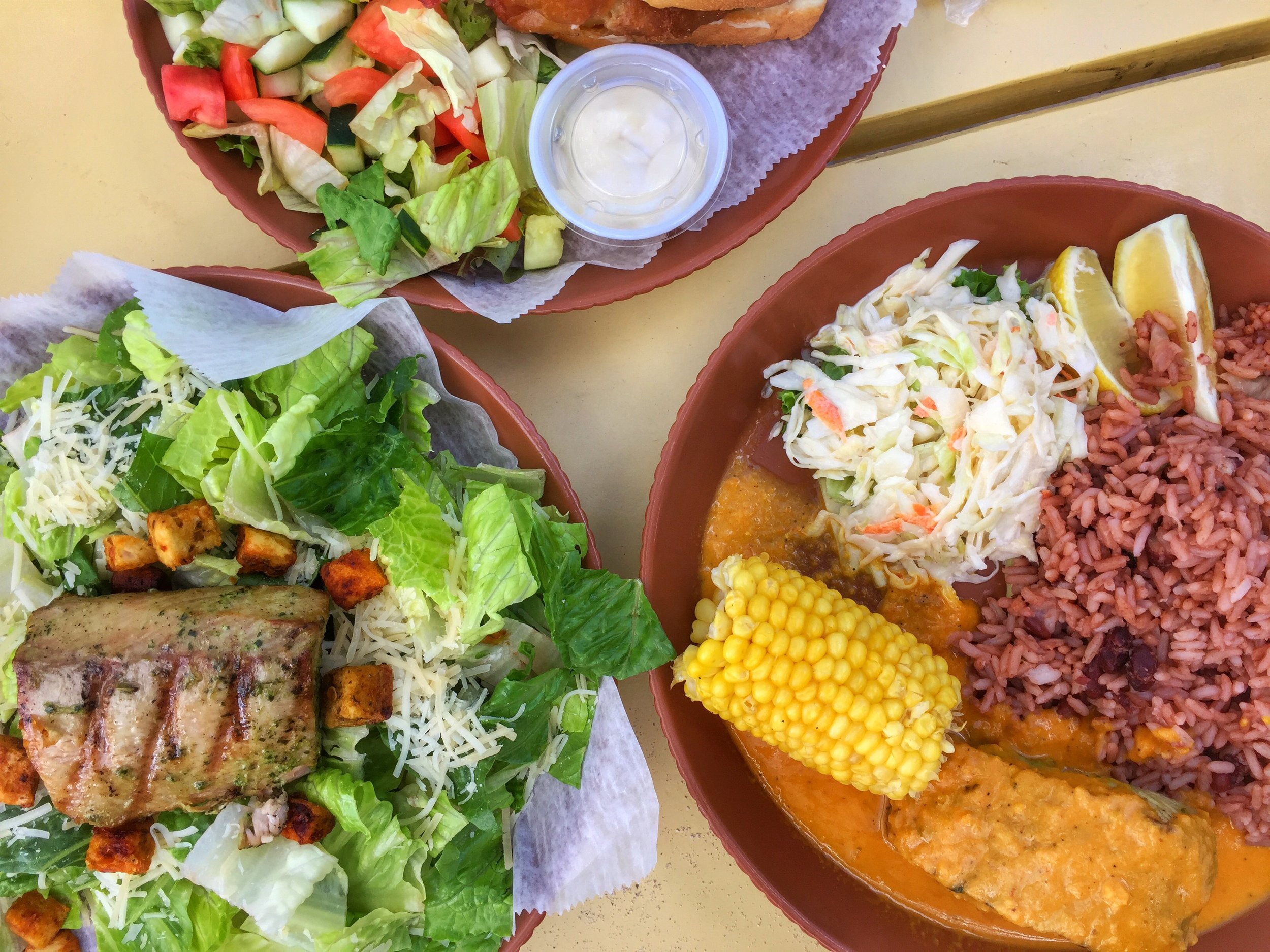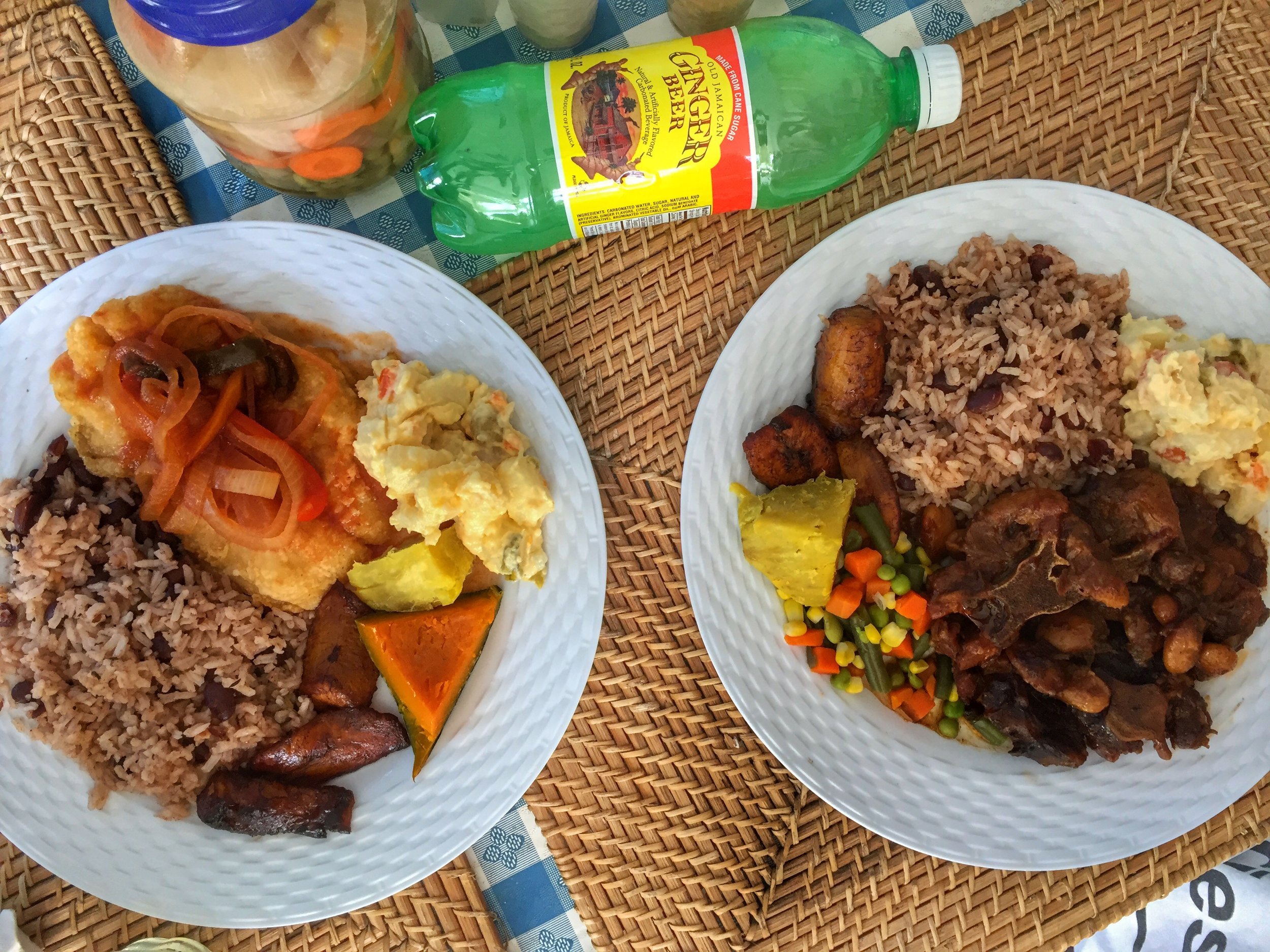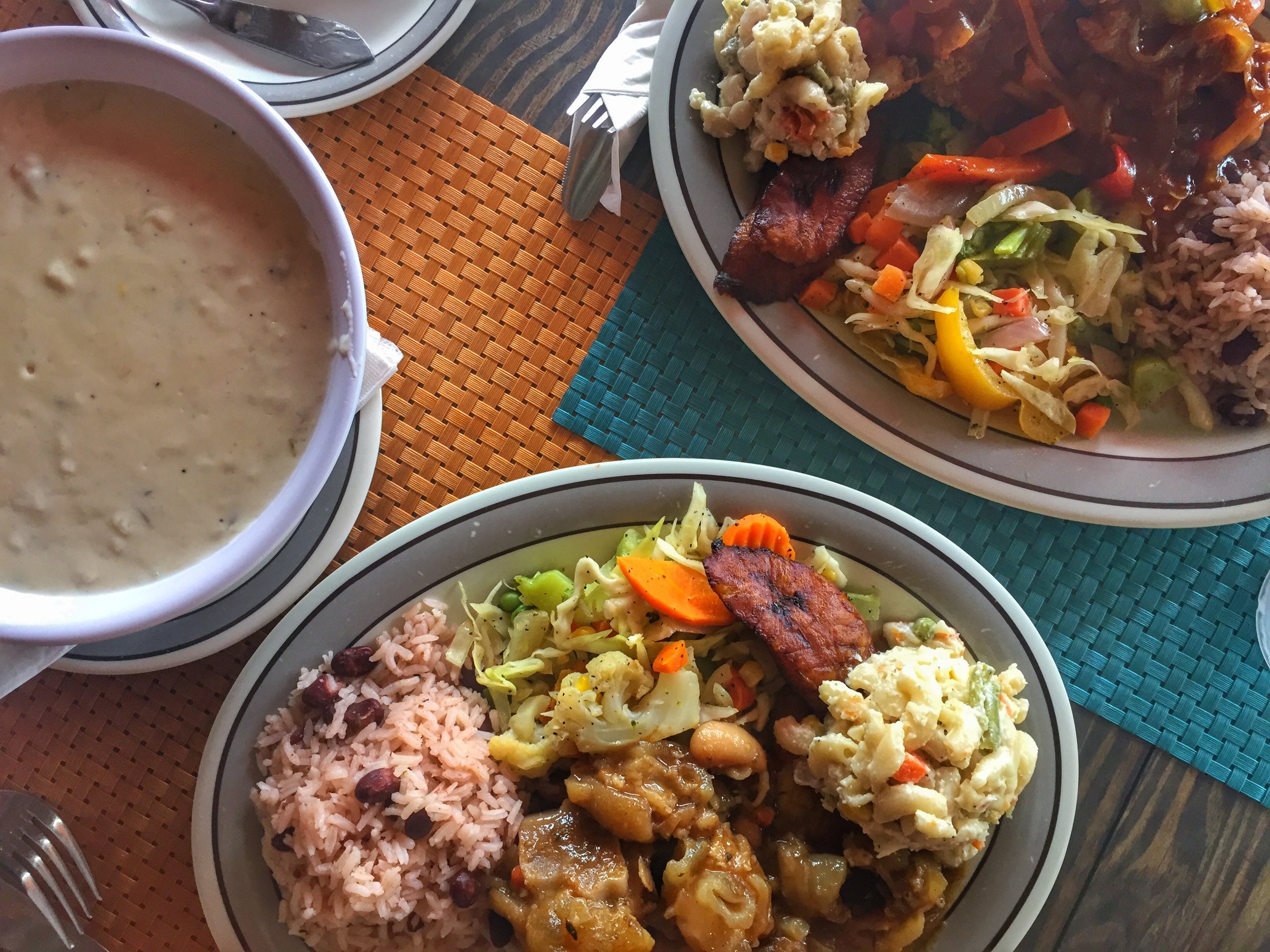Grand Cayman: A Snowbird’s Diet
When someone you know offers to share their timeshare - located in a tropical clime, no less - you say ‘yes’. This was the case for Kim and Nick, who travelled to Grand Cayman with Kim's mother for a week of sun, sand, and - yes - food. Welcome to the Canadian snowbird life. Welcome to Grand Cayman.
A couple things cross one’s mind when the Caymans are mentioned. Sprawling beaches and warm weather - sure. Rum and light, crisp beer? Perhaps. Tax evasion and fat cats? Most definitely. But for a couple with a one-track mind this vacation wouldn’t be complete with mere relaxation. We wanted food.
On this island, it’s easy to fall into the trap of effortlessness offered by a small island dominated by tourists (predominantly American and British) and resorts. You could spend an entire week subsisting on fare easily found anywhere. We remain confused by ‘local’ recommendations whose menus typically include burgers and fries, pastas, and - frankly - mundane Americanized options. How is that authentic Caymanian?
The key to the Caymans, and perhaps the heart of the island itself, lies in the waterside shacks and eateries scattered by beaches and roadsides. Our universal travel tip: the closer the restaurant looks to a lawn chair extension of a mother’s kitchen, the better the cooking.
Conch, a staple in most West Indian countries, was the first thing we searched for on the island. It’s typically served either raw in a ceviche, or cooked in fritters, soups, stews, or curries. In the Caymans, conch fritters are a permanent fixture on the appetizer menu of almost every restaurant that serves local fare. The texture is chewy, similar to the surf clam you find at sushi bars, so it’s advisable to sample the sea snail in dishes where it is cut into thin pieces. Kim once made the mistake of ordering it as a steak, resulting in aching jaws and little return. Never again.
We had conch many times during our stay, but our favourite was the Conch Ceviche at Macabuca Oceanside Tiki Bar and Grill. Dressed with lime, onions, tomatoes, and peppers, ceviche is likely the softest and most flavourful way to eat conch; the preparation highlights the conch as the main ingredient. It’s easily lost in more cooked preparations.
The Conch Fritters at Macabuca were equally well-seasoned and well-executed. They’re doughnut hole-sized balls of fried batter well-incorporated with bits of chopped conch. While it’s easy to find conch fritters virtually everywhere on the island, it’s equally easy to find lackluster fritters: at its worst, it’s merely seafood-flavoured dough.
As equally ubiquitous on the island is fish; any edible species battered and fried, and most commonly served in a sandwich or smothered in escovitch - a sweet & sour onion sauce with a base of onions and tomatoes that frankly reminds us of Chinese Canadian cuisine (but delicious, nonetheless).
Macabuca’s Lionfish was the outstanding dish of the day. Lionfish has a flaky white flesh similar to that of a grouper, and is good eats despite how grotesque they look. The finely-textured fish came battered, fried, and pressed into a coconut bread bun, along with escovitch tomato mayo, pickled carrots, onions, and peppers. The coconut bread added a beautiful fragrance and the lionfish was perfectly cooked - the batter was light and crunchy, not too oily.
We later discovered that by eating lionfish, we were in fact helping the environment. Lionfish are non-native to the Atlantic Ocean, but over the past 2 decades have appeared in large numbers. Their presence is a threat to the ecosystem, as these carnivorous and venomous fish have very few predators. Left unchecked, lionfish feed on small fish and crustaceans to a degree that can potentially lead to their extinction, and compete with native species for resources. In addition to being good for the environment, it’s also good for you! Lionfish are high in Omega 3 fatty acids, are lower in saturated fats, and contain less heavy metals, like mercury, compared to other common local fish.
Next on our list of animals to eat was sea turtle. They’re synonymous with the Cayman Islands: when Christopher Columbus discovered the island in 1503, he named them “Las Tortugas” due to the abundance of sea turtles in the waters. While wild sea turtles are protected and the Islands are active in research and conservation efforts, farmed turtles are part of a traditional Caymanian menu. It’s mildly disconcerting; like looking for bald eagle dishes while traveling the U.S. But, when in Rome ...
Over The Edge was a recommendation for turtle meat on the north-east tip of the island. While Caymanians typically enjoy turtle meat in stews, Over The Edge - and most other restaurants we went to - served turtle steak. The dish was by no-means a looker - just thin chunks of meat smothered in a port and vegetable gravy. Interestingly, the meat was in no-ways offensive. Served without identification, one could easily confuse the dish with pork; it’s a fine white meat with the same striated muscle texture as flank steak or chicken breast.
Would we sample turtle again? Perhaps only to experience a cut of darker meat.
Up to this point, we’d noshed at seaside watering holes - it was time to step further off the tourist path: into a real Caribbean kitchen. To identify such kitchens in the wild, just look for these common markings: open-air extensions to residential homes, outdoor furniture, and ‘Daily Special’ boards hand-drawn on office rejects. Take heed; ignore the rest of the menu and just order from the daily specials - that’s where the authenticity is at.




Vivine’s Kitchen is one such spot. From the menu that day, we tried the oxtail stew and the fried grouper with all the fixins: rice and beans, plantains, steamed vegetables, potato salad - a formula that's commonplace across the island. We found that if you’re not sure what to eat, always go for the fish, preferably the catch of the day - whether fried, grilled, or blackened. 95% of the time, the fish is cooked to perfection in the Caymans.
While the fish, as usual, was great, the oxtail stew was phenomenal. It’s a saucy, slow-cooked affair designed to be smothered over rice and vegetables, only to be mopped up with any leftover frybread at the end of the meal. Need we describe oxtail, simmered in a palate-coating brown sauce redolent of peppers and onions? We didn’t think so.
Another local hole-in-the-wall closer to the East side of the island is Kurt’s Corner. After a quick scan of the now-familiar whiteboard of daily specials, Nick knew exactly what he was going to order: cow’s feet.
Cow’s feet is a Caymanian and Jamaican tradition. It’s a nose-to-tail style of cooking likely born out of pragmatic necessity rather than ecological mandate, but the results are, nonetheless, delicious. Pieces of the shin, closest to the hoof, were stewed for hours into a smooth, curry-tinted sauce. It’s kitchen transmutation; refuse turned to rib-sticking fare, with tendons that slip off the bone and commingle harmoniously with the obligatory rice and beans.
A note on the frybread: it’s not really bread in the Western sense of the word. More like savoury doughnut bites, with the flavour and texture much like the type of fried dough found at Chinese restaurants. Kurt’s serves a particularly mean version accompanied with garlic butter. The butter is hardly necessary, but let’s be honest: who counts calories on holiday? Do the butter.
We ended the meal with a Cassava Cake. Mauritians have their own version of this dessert, so Kim and her mother were excited for a comparison. Unlike their slightly lighter version, this cassava cake was a dense sponge heavily spiced with cinnamon, clove, and brown sugar. Completely necessary was the whipped cream and chocolate and strawberry sauce drizzle. We were glad we split one 3 ways.
Unlike many vacation getaways, we had the luxury of a fully-appointed kitchen at our disposal. Taking advantage of some local produce and meat, we took home some plantains and cassava (yuca) to accompany a beautiful cut of local tuna.


Plantains are abundant in most, if not all, tropical climates and grow year-round, making it a staple in the West Indies. There are a variety of ways to cook this banana cousin, which can be eaten green or ripe. We opted for a couple of ripe ones. They’re best simply prepared - sliced diagonally and caramelized in a pan with liberal dose of butter.
Cassava, also known as yuca, is a root vegetable that can also be found in most tropical countries. As it is so widely consumed around the world, there are a variety of ways in which it can be prepared. Mauritius-born, and having eaten a lot of cassava in her lifetime, Kim’s mother suggested that we simply boil it and toss it in butter. Enlivened by a squirt of lime, it’s comfort-food delicious. Cassava reminds Kim of chewy potato, which is probably why she enjoyed it so much.
On our last night in Grand Cayman, we splurged on a more upscale experience at the Lobster Pot. Located in the touristic hub of Georgetown, the Lobster Pot is a departure from our island-hut experiences. Unsurprisingly, lobster was had that night - it’s a tragic mistake to ignore the very name of an establishment.
The lobster you find in the Caribbeans is not the same as the ones you’ll find on the eastern shores of North America. In fact, they’re a completely different species altogether. The Caribbean Spiny Lobster has no claws and resembles a giant prawn. We found the meat to be slightly tougher than its cold water cousin’s and more mild. Still, a perfect vessel for drawn butter and good times.
Our final hours on the island left room for one more sampling of local fare: a goat curry roti from Singh’s Roti Shop. For breakfast. Yes, breakfast.
Having feasted on seafood the night before, our hosts - Canadian expats and distant relatives - insisted that a goat curry roti was perfect for the road. It didn’t require much arm-twisting. Goat curry is one of our absolute favourite curries and we rarely, if not never, turn it down.
No, this was not strictly Caymanian fare; Singh’s touts itself as Trinidadian cuisine. But like many countries with close borders and migratory workers, overlap is inevitable. Goat curry is popular in the Caymans, along with other derivatives of Jamaican influence, such as jerk chicken and patties.
Like all roti, this one was a brick of island sustenance: simmered curry folded into a wheat and lentil wrap into a meal the size of a football. A single serving proved enough for 3 hungry travellers reluctant for departure.
It was with full bellies and sun-warmed hearts that we bid farewell to the Cayman Islands. A country whose cuisine reflects the laid-back soul of its inhabitants, and the bounty of the sea.
Words and photos by Kimberley Kwo and Nicholas Wong.
